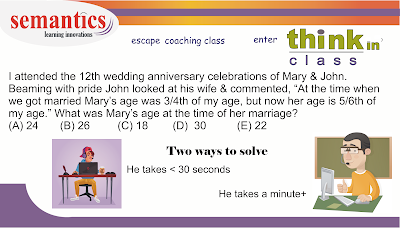I trained a student for GMAT. Let me share my
experiences with you:
He had written GMAT and got a score of 500. He had prepared
for 2 months. This was his preparation
- He had 2 GB of downloaded material- different books/different videos. He went through them once.
- He studied GMAT official guide twice.
- He went through different forums. And collected strategies from different answers posted there
This is my observation:
His knowledge of mathematical formula was strong.
He could remember the
formula for area of the equilateral triangle, formulae in trigonometry and
other conceptual formulae. He could also remember intricate details like the
height of the equilateral triangle, the formula to arrive at the in-centre of
the circle….
However. when he saw tough problems he couldn’t proceed
beyond the first stage in the problem solving process (identifying what formula
to use). He knew which formula to apply but he didn’t know how to apply the
formula.
In verbal his vocabulary was strong.
He knew some grammar concepts like subject verb agreement,
errors due to misplaced modifier, pronoun errors, ambiguous use of ‘which’ and
‘it’ and few more error types.
In critical reasoning he went by his gut feeling to get his answers.
He could eliminate 3 options, but two options were very
close. He guessed the answer.
Extra reading
He briefly dilly dallied by reading the local newspaper.
Here is a typical case of GMAT student who presume he/she can prepare for GMAT in less than a month.
I suggested the following things and I closely monitored his training
- I selected (edited obviously) GMAT like passages from various sources in the net, the topics covered business, philosophy, anthropology, science….
- I exposed him to 25 different errors commonly asked in GMAT sentence correction. I didn’t go back to high school grammar. I found that, the knowledge in high school grammar is too elementary to teach sophisticated error identification.
- For critical reasoning, I took him through a course in logic. I taught him how to identify arguments, how to identify fallacies in the argument. I designed an algorithm (a step by step process) to arrive at an answer for critical reasoning questions. There are 10 different types of CR questions. Hence 10 different algorithms.
- For math I taught him how to critically analyze mathematical problem, how to determine the variables in a problem, how to define relationships in the variables, how to derive hidden relationships. How to diagram the problem.
- Further I taught him faster means of solving equations, working backwards with the answer options and also how to effectively eliminate answers by using deductive reasoning.
- I taught him for 3 weeks and then I gave him problems to practice on and told him to classify problems in the OG.
- I told him to take 4 full tests. He was averaging around 620 in them.
He eventually got 660.
I wish he had met me earlier, he could have saved one GMAT attempt .
For him 650 was his target score.
For a person to reach 720+, a different strategy is
employed. More on that in my next post.



















